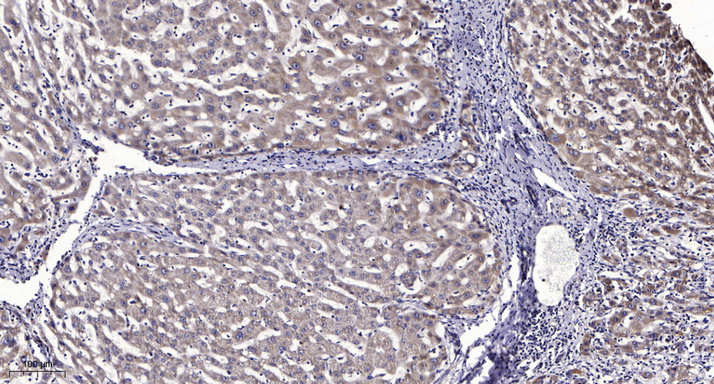LRP6 (Phospho Thr1479) rabbit pAb
- Catalog No.:YP1599
- Applications:WB;ELISA;IHC
- Reactivity:Human;Mouse
- Target:
- LRP6
- Fields:
- >>mTOR signaling pathway;>>Wnt signaling pathway;>>Parathyroid hormone synthesis, secretion and action;>>Alzheimer disease;>>Pathways of neurodegeneration - multiple diseases;>>Pathways in cancer;>>Breast cancer;>>Hepatocellular carcinoma;>>Gastric cancer
- Gene Name:
- LRP6
- Protein Name:
- LRP6 (Phospho Thr1479)
- Human Gene Id:
- 4040
- Human Swiss Prot No:
- O75581
- Mouse Gene Id:
- 16974
- Mouse Swiss Prot No:
- O88572
- Immunogen:
- Synthesized peptide derived from human LRP6 (Phospho Thr1479)
- Specificity:
- This antibody detects endogenous levels of Human,Mouse LRP6 (Phospho Thr1479)
- Formulation:
- Liquid in PBS containing 50% glycerol, 0.5% BSA and 0.02% sodium azide.
- Source:
- Polyclonal, Rabbit,IgG
- Dilution:
- WB 1:500-2000;IHC 1:50-300; ELISA 2000-20000
- Purification:
- The antibody was affinity-purified from rabbit serum by affinity-chromatography using specific immunogen.
- Concentration:
- 1 mg/ml
- Storage Stability:
- -15°C to -25°C/1 year(Do not lower than -25°C)
- Other Name:
- Low-density lipoprotein receptor-related protein 6 (LRP-6)
- Observed Band(KD):
- 177kD
- Background:
- This gene encodes a member of the low density lipoprotein (LDL) receptor gene family. LDL receptors are transmembrane cell surface proteins involved in receptor-mediated endocytosis of lipoprotein and protein ligands. The protein encoded by this gene functions as a receptor or, with Frizzled, a co-receptor for Wnt and thereby transmits the canonical Wnt/beta-catenin signaling cascade. Through its interaction with the Wnt/beta-catenin signaling cascade this gene plays a role in the regulation of cell differentiation, proliferation, and migration and the development of many cancer types. This protein undergoes gamma-secretase dependent RIP- (regulated intramembrane proteolysis) processing but the precise locations of the cleavage sites have not been determined.[provided by RefSeq, Dec 2009],
- Function:
- disease:Defects in LRP6 are the cause of autosomal dominant coronary artery disease type 2 (ADCAD2) [MIM:610947].,domain:The YWTD-EGF-like domains 1 and 2 are required for the interaction with Wnt-frizzled complex. The YWTD-EGF-like domains 3 and 4 are required for the interaction with DKK1.,function:Essential for the Wnt/beta catenin signaling pathway, probably by acting as a coreceptor together with Frizzled for Wnt. Specific high-affinity receptor for DKK1 and DKK2, but not DKK3. The interaction with DKK1 blocks LRP6-mediated Wnt/beta catenin signaling via LRP6 removal via Kremen proteins-mediated endocytosis.,similarity:Belongs to the LDLR family.,similarity:Contains 20 LDL-receptor class B repeats.,similarity:Contains 3 LDL-receptor class A domains.,similarity:Contains 4 EGF-like domains.,subunit:Interacts with RSPO1 and RSPO3 (By similarity). Interacts with FZD5. Essential componen
- Subcellular Location:
- Cell membrane ; Single-pass type I membrane protein. Endoplasmic reticulum . Membrane raft . On Wnt signaling, undergoes a cycle of caveolin- or clathrin-mediated endocytosis and plasma membrane location. Released from the endoplasmic reticulum on palmitoylation. Mono-ubiquitination retains it in the endoplasmic reticulum in the absence of palmitoylation. On Wnt signaling, phosphorylated, aggregates and colocalizes with AXIN1 and GSK3B at the plasma membrane in LRP6-signalsomes. Chaperoned to the plasma membrane by MESD (By similarity). .
- Expression:
- Widely coexpressed with LRP5 during embryogenesis and in adult tissues.
- June 19-2018
- WESTERN IMMUNOBLOTTING PROTOCOL
- June 19-2018
- IMMUNOHISTOCHEMISTRY-PARAFFIN PROTOCOL
- June 19-2018
- IMMUNOFLUORESCENCE PROTOCOL
- September 08-2020
- FLOW-CYTOMEYRT-PROTOCOL
- May 20-2022
- Cell-Based ELISA│解您多样本WB检测之困扰
- July 13-2018
- CELL-BASED-ELISA-PROTOCOL-FOR-ACETYL-PROTEIN
- July 13-2018
- CELL-BASED-ELISA-PROTOCOL-FOR-PHOSPHO-PROTEIN
- July 13-2018
- Antibody-FAQs
- Products Images

- Immunohistochemical analysis of paraffin-embedded human liver cancer. 1, Antibody was diluted at 1:200(4° overnight). 2, Tris-EDTA,pH9.0 was used for antigen retrieval. 3,Secondary antibody was diluted at 1:200(room temperature, 45min).


